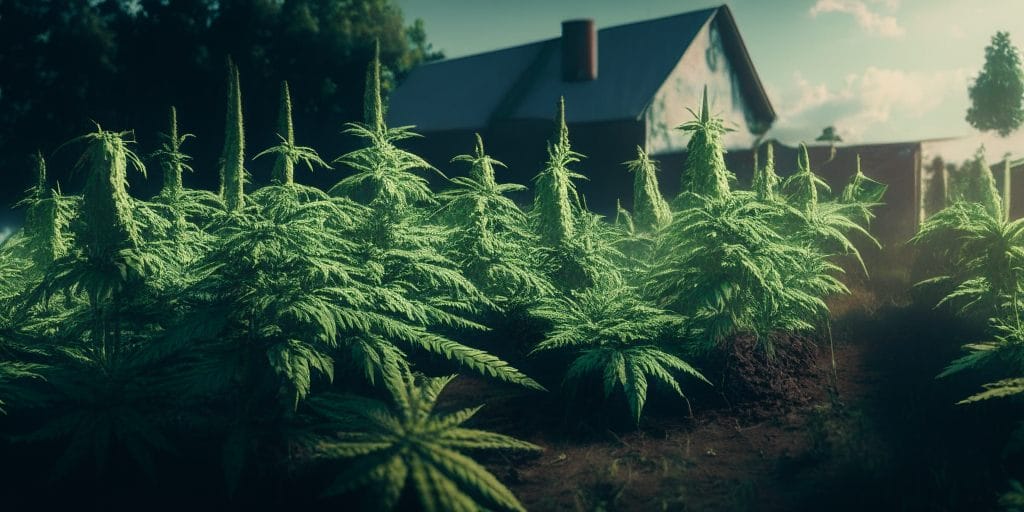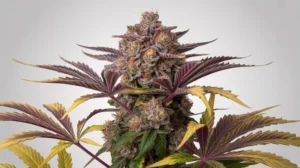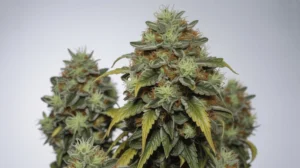Exploring the Best Cover Crops for Cannabis Farms

In the realm of organic cultivation, cannabis farms are turning to cover crops to foster a healthier ecosystem and a more sustainable future. These eco-friendly plants serve as silent guardians of soil health, bolstering fertility and biodiversity with remarkable ease. From the deep-rooting radishes to the nitrogen-enthused clovers, each cannabis-friendly cover crop species brings its unique strengths to the table, providing a tapestry of benefits beneath the canopy of thriving cannabis leaves. Join us as we examine the best cover crops for cannabis.
Key Takeaways
- Understanding the role of cover crops in sustaining a vibrant cannabis farm ecosystem
- Evaluating the best species that complement and enhance cannabis growth
- Appreciating the eco-friendly advantages of implementing cover crops
- Discovering how to seamlessly integrate beneficial cover crops into weed farming practices
- Identifying species that naturally support the diverse needs of cannabis cultivation
The Importance of Cover Crops in Cannabis Cultivation
Acknowledging the fundamentals of sustainable organic agriculture is essential when considering the growth and health of any cultivation, particularly that of cannabis. The strategic application of cover crops stands as an embodiment of nature’s resilience and efficiency. Let us delve deeper into the core principles that make cover crops so vital in building soil health for cannabis, along with their inherent ability for erosion prevention and establishing a dynamic soil food web in your garden.
Principles of Sustainable Organic Agriculture
Emulating the natural environment’s cyclical pattern, sustainable organic agriculture promotes a holistic approach. At its heart lies the minimal disturbance of the soil, allowing a diverse population of organisms to thrive which is central to the philosophy of soil food web gardening. This not only conserves energy but also fosters a natural balance in the ecosystem. Here’s a snapshot of these eco-friendly methodologies:
- Mulching with organic materials to modulate soil temperature and moisture levels
- Incorporating green manure from cover crops to enhance soil nutrient content
- Choosing cover crops that naturally fortify the soil against pests and diseases
Benefits: Soil Health and Erosion Prevention
Cover crops serve as a protective mantle for soil, shielding it from the erosive forces of wind and water. In the special case of cannabis cultivation, these crops are particularly adept at maintaining soil integrity and preventing the loss of topsoil. This natural armor is essential for preserving not only the fertility of the land but also safeguarding surrounding ecosystems from the detrimental effects of sediment overflow.
| Cover Crop | Soil Health Benefit | Erosion Prevention Role |
|---|---|---|
| Cereal Rye | Improves soil structure, adds biomass | Reduces soil compaction, controls runoff |
| Clover Varieties | Nitrogen fixation, feeds beneficial microbes | Excellent ground cover to prevent soil displacement |
| Buckwheat | Quick growth, improves nutrient availability | Protects soil in between seasonal rotations |
Understanding the Soil Food Web
The soil food web is an intricate tapestry of life that exists within the soil. Comprising a multitude of organisms from bacteria and fungi to arthropods and earthworms, this community plays a pivotal role in decomposing organic matter, cycling nutrients, and enabling vigorous plant growth. The judicious use of cover crops in cannabis farms can bolster the soil food web, curating a garden that is not only lush but teeming with healthy biodiversity.
By adorning the soil with a diverse range of cover crops, cannabis cultivators can stimulate a multifaceted soil food web that is both a beneficiary and benefactor in the quest for sustainable growth and productivity.
As we continue to explore the complexities of cover crops, it becomes increasingly clear that their proper integration into cannabis cultivation is pivotal—not only for the plant’s immediate welfare but for the enduring vitality of the very ground it grows in.
Identifying the Best Cover Crop Species for Cannabis Farms
For those dedicated to improving the health of their cannabis farms, selecting ideal cover crops for cannabis cultivation is not just a practice—it’s an essential chapter of farm management. Cover crops are not merely fillers; they are dynamic players in the agricultural ecosystem that work harmoniously with your primary crop to create a resilient growing environment.
Key attributes for the recommended cover crop species for marijuana farms include rapid growth to outcompete weeds, extensive leaf production which provides ground cover and organic matter, and non-competitiveness to ensure they don’t become invasive. The main goal is to establish a cover crop that integrates seamlessly with the lifecycle of your cannabis plants.
- Legumes: Clovers and alfalfa are praised for their nitrogen-fixing abilities, which are critical for supplementing the nutritional needs of cannabis plants without the need for synthetic fertilizers.
- Grasses: Species such as cereal rye offer substantial carbon input and soil structure benefits, enhancing the organic matter content and promoting a healthy soil ecosystem.
- Brassicas: Crops such as radishes provide exceptional pest management benefits, with some species also aiding in soil compaction relief.
Combining Cover Crops
In the quest for the best companions for your cannabis, consider the following combination of cover crops:
| Cover Crop | Nitrogen Fixation | Soil Structure | Pest Management |
|---|---|---|---|
| Clovers | High | Medium | Low |
| Alfalfa | High | High | Medium |
| Cereal Rye | Low | High | Medium |
| Radish | None | Medium | High |
Mixing legumes with grasses or brassicas can create a cover crop cocktail that maximizes benefits while minimizing potential drawbacks. By fostering such biodiverse living mulches, cannabis farmers can ensure a thriving ecosystem that supports the robust growth of their primary crop.
Legumes: The Nitrogen-Fixing Champions
In the quest for sustainable agriculture, legumes play a pivotal role as formidable allies for enhancing soil fertility. Their unique ability to fix atmospheric nitrogen, turning it into a valuable plant nutrient, stands at the core of their contribution to agroecosystems. This natural process, symbiotically executed with soil bacteria, mitigates the need for synthetic fertilizers and bolsters soil health. In the context of cannabis cultivation, the strategic use of nitrogen-fixing cover crops is a vital component for improving yields while adhering to organic farming methodologies.
Role of Legumes in Enhancing Soil Fertility
Legumes are not just plants; they are also skilled bio-fertilizers. As they grow, they form partnerships with rhizobia bacteria to create root nodules. These nodes become the workshop for nitrogen fixation—a remarkable alchemy where the inert gas from the atmosphere is converted into nitrogen compounds that plants can absorb. This noble act enriches the soil with organic matter and essential nutrients, subsequently promoting the vitality and health of subsequent crops like cannabis.
Popular Legume Cover Crops: Clovers and Alfalfa
Farmers have long capitalized on the alfalfa benefits in agriculture, praising it for its durability, adaptability, and the substantial nitrogen content it contributes to the soil. Similarly, clover as a cover crop is a celebrated choice for its nitrogen-fixing abilities, competitive weed suppression, and even as a forage crop for pollinators—boosting biodiversity in the process. Below is a comparison of various clover species and alfalfa, highlighting their utility in agricultural settings:
| Cover Crop | Nitrogen Fixation Rate | Soil Improvements | Additional Benefits |
|---|---|---|---|
| Crimson Clover | High | Excellent weed suppression | Early maturation |
| Red Clover | Moderate to High | Good for heavy soils | Perennial with high biomass |
| White Clover | Moderate | Great for grazing and minimal maintenance | Attracts beneficial insects |
| Alfalfa | Very High | Deep taproots break up compact soil | Drought-resistant once established |
Whether you choose clover varieties or alfalfa, their role is fundamental to sustaining fertility and structure in the soils of cannabis farms. By selecting the appropriate nitrogen-fixing cover crops, growers invest in the long-term health of their land, contributing to the overarching paradigm of resilient and eco-conscious agriculture.
Grasses and Grains: Carbon-Rich Soil Enhancers
In the quest for sustainable agriculture, selecting the optimal cover crops is critical. Grasses and grains emerge as champions in enriching the soil’s organic matter, offering a sustainable solution for soil structure improvement. Here, we delve into the role these carbon-rich cover crops play and how choices like cereal rye, oats, and wheat contribute to a healthier, more productive soil ecosystem.
Advantages of Grasses for Soil Structure
The intricate web of grass roots creates a framework within the soil that is perfect for fostering a strong, resilient structure. Their ability to produce an abundance of biomass not only boosts soil organic carbon, but also aids in moisture retention while providing essential nutrients as the plant materials decompose. This biological process is a cornerstone in improving the overall soil texture and facilitating efficient nutrient cycling, essential for optimal plant growth.
Selecting the Right Grasses: From Rye to Barley
Choosing the right type of grass or grain as a cover crop is pivotal for reaching the desired outcomes in terms of soil enhancement. Common selections include:
- Cereal Rye: Renowned for its hardiness and deep root system, making it an excellent option for preventing soil erosion.
- Oats: Known to foster weed suppression while enhancing soil tilth, a key factor in preparing seedbeds for subsequent crops.
- Wheat: Often chosen for its robust growth, which adds significant biomass to the soil, and its capacity for suppressing common crop pests.
The integration of these grasses into a crop rotation plan can greatly balance the soil’s carbon-to-nitrogen ratio, particularly when paired with nitrogen-fixing legumes. The interplay between the fibrous structure of grasses and the nutrient-enrichment properties of legumes results in an agronomic synergy that promotes long-term soil fertility and health.
| Cover Crop | Carbon Contribution | Root System Characteristics | Additional Benefits |
|---|---|---|---|
| Cereal Rye | High | Extensive, deep | Erosion control, weed suppression |
| Oats | Medium | Fibrous, dense | Soil tilth improvement, frost protection |
| Wheat | Medium-High | Robust, widespread | Biomass production, pest suppression |
As indicated in the table, each grass offers unique benefits and contributes differently to the soil’s carbon content. Their selection and management should be tailored to the specific needs of the farm’s soil and the main crops cultivated. Overall, the use of grasses and grains as part of a cover crop strategy embodies the essence of eco-farming and stands as a testimony to agriculture’s potential harmony with nature’s processes.
Brassicas and Broadleaves: Pest Management Allies
Incorporating brassicas and broadleaf cover crops into your agricultural strategy can transform your farm’s approach to pest management. Known for their unique ability to suppress pests and improve soil health, these powerful plant allies offer eco-friendly solutions to some of the most common agricultural challenges.
Brassicas: Biofumigants for Healthier Soils
Brassicas, such as mustard and oilseed radish, are not only nutritious vegetables but also acclaimed for their biofumigant properties. These plants emit natural compounds that provide a protective effect, assisting in the management of soil-borne pests and diseases. This characteristic is remarkably advantageous on cannabis farms where maintaining soil health is imperative for high-quality yields.
| Brassica Species | Biofumigant Compounds | Benefits in Pest Management |
|---|---|---|
| Mustard (Brassica juncea) | Glucosinolates | Suppresses nematodes, fungi, and weeds |
| Oilseed Radish (Raphanus sativus) | Isothiocyanates | Reduces pathogen load and aerates soil |
Broadleaf Cover Crops: More Than Just Weeds
Beyond their role in weed suppression, broadleaf cover crops like buckwheat and phacelia bring an array of advantages to the farm ecosystem. By breaking up compacted soil and adding biodiversity to the crop rotation, these plants contribute to forming a more resilient and productive soil milieu, which is of great value for the health and vitality of cannabis plants.
- Buckwheat quickly accumulates biomass, enriching the soil with organic matter
- Phacelia, with its deep taproot, is an efficient soil conditioner and attracts a variety of pollinators
Beyond their practical benefits, these broadleaf crops also feature blossoms that enhance the visual appeal of the farm landscape, promoting a healthier and more vibrant ecosystem.
The Science Behind Green Manure
Delving into the science of green manure, we uncover a pivotal process within agriculture that vastly improves soil health through the reuse of cover crops. The practice of converting these plants back into the soil not only reemploys old resources but also harnesses their inherent ecological benefits.
Transforming Cover Crops into Soil Nutrients
Green manure reinvigorates the concept of soil nutrient cycling by transforming decayed plant material into a rich source of organic matter. Once plowed back into the earth, these cover crops begin to decompose, releasing nutrients—such as nitrogen, phosphorus, and potassium—that are essential for the subsequent growth of crops, including nutrient-demanding plants like cannabis.
The Long-Term Benefits of Green Manure on Soil Quality
The long-term rewards of incorporating green manure into agricultural practices are multifaceted. This technique is responsible for substantially enhancing organic matter in agriculture, which leads to better water retention, improved soil structure, and robust microbial life—all of which culminate in a supremely fertile soil environment.
| Green Manure Benefits | Impact on Soil Quality |
|---|---|
| Organic Matter Increase | Boosts soil nutrient content and structure |
| Soil Aeration | Enhances the growth and activity of soil organisms |
| Moisture Retention | Prevents water evaporation, preserving vital soil moisture levels |
| pH Regulation | Potentially lowers soil pH, benefiting acidity-preferential crops |
| Weed Suppression | Reduces the proliferation of unwanted plants through natural means |
Mulching with Cover Crops for Optimal Moisture Conservation
As environmental stewardship takes center stage in farming practices, one cannot overlook the importance of mulching, particularly within cannabis cultivation. This age-old technique forms the linchpin of sustainable agriculture, serving multiple roles from soil enrichment to moisture conservation. Integrating mulching techniques for cannabis into the cultivation process fortifies plants against the vagaries of weather, ensures moisture conservation in farming, and utilizes organic mulch materials that enrich the soil biota.
Organic Mulches: Benefits Beyond Moisture Retention
Organic mulches, consisting of natural materials like straw, wood chips, and compost, are more than mere barriers to water evaporation. Their decomposition over time releases valuable nutrients, feeding the soil and fostering a living ecosystem beneath our feet. Plus, these organic layers act as natural blankets, keeping soil temperatures steady and roots happy, especially critical for the heat-sensitive cannabis plant.
- Straw: A lightweight option that allows for easy application and is excellent for retaining soil moisture.
- Wood Chips: These take longer to decompose, providing a longer-lasting mulch layer and contributing to the soil’s structural integrity.
- Compost: Rich in nutrients, it can simultaneously mulch and fertilize, promoting vigorous cannabis growth.
Techniques for Effective Mulching in Cannabis Farmland
When it comes to applying mulch in cannabis farming, precision and timing are key. A layer too thin may not prevent weed growth effectively, or conserve enough moisture, while too thick a layer can impede soil breathing and cause root rot. Mulching after irrigation or rainfall, ensuring the soil is moist before application, maximizes its moisture-retaining properties.
To put these methods into action on a cannabis farm:
- Assess the moisture level in the soil and irrigate if necessary before applying mulch.
- Apply a 2- to 4-inch layer of organic mulch around the base of the cannabis plants, avoiding direct contact with the stems to prevent rot.
- Check periodically for any signs of over-moisture or pest infestation, and adjust the mulch layer as needed.
The right mulching strategy can make all the difference in a cannabis farm’s yield and sustainability. By using organic materials native to the region and applying them thoughtfully, growers can harness the full potential of nature’s blanket. Embrace these mulching techniques and watch as the farming ecosystem thrives, showcasing a balance of moisture conservation, plant vigor, and soil vitality.

Addressing the Disadvantages: Mitigating Risks with Cover Crops
Despite their well-documented benefits, cover crops can present a set of challenges that farmers must address with meticulous cover crop management. Conspicuously, the risk of germination suppression issues could derail the success of a subsequent main crop, such as cannabis, if not properly managed. In this section, we’ll delve into the strategic approaches required for strategic crop termination, ensuring that cover crops continue to be allies rather than adversaries in cannabis cultivation.
Germination Suppression and Management Strategies
Germination suppression is the principal downside to the protection afforded by cover crops. The allopathic compounds released by certain grasses and brassicas can inhibit the germination of seeds, compromising the establishment of the intended cash crop. Avoiding these adverse effects necessitates a clear understanding and application of the right management strategies. Employing a waiting period between the termination of cover crops and the sowing of cannabis is critical. This interval allows the decomposition of potentially harmful residues, reducing the risk from natural inhibitors.
Timing and Methods of Cover Crop Termination
Choosing the correct timing and methods for terminating cover crops is imperative to prevent them from becoming overly competitive with your main crop. The table below delineates various termination methods and their suitable timing to ensure beneficial outcomes:
| Termination Method | Ideal Timing | Benefits |
|---|---|---|
| Mowing or Crimping | Before seed maturity | Minimizes soil disturbance; preserves soil structure |
| Tillage | Post-harvest | Accelerates decomposition; faster nutrient release |
| Herbicides | As needed based on crop growth | Targeted action; conserves time |
| Roller-crimper | At crop maturity | Creates a mulch layer; suppresses weeds without chemicals |
| Grazing | Varies with livestock and crop type | Integrates livestock; natural mowing and fertilization |
By taking these methodologies into consideration, farmers can administer an orderly segue between cover crops and the cultivation of cannabis—ensuring the concurrent sustenance of soil vitality and plant prosperity.
Incorporating these approaches into a holistic farm management plan will help mitigate the downsides and amplify the benefits that cover crops impart to cannabis farming. Careful coordination and application of knowledge can lead to a thriving, productive, and sustainable cannabis farm environment.
Eco-friendly Practices: Cover Crops and Financial Incentives
In today’s agricultural landscape, the implementation of sustainable agriculture practices is not just a matter of environmental stewardship, but also of financial prudence. Among these practices, the use of cover crops stands out as a leading strategy for improving soil health and farm productivity. Beyond the clear economic benefits of cover crops, there are additional financial incentives available to farmers, making the shift to eco-friendly agriculture an attractive proposition.
Cost-Benefit Analysis of Using Cover Crops
While the initial costs associated with purchasing and planting cover crops may seem like a hurdle, the long-term savings and gains paint a different picture. Reduced need for synthetic fertilizers, enhanced water retention, and improved yield resilience are key factors that contribute to the overall cost-effectiveness of this approach. To quantify these advantages, a cost-benefit analysis is essential, underlining how cover crops can lead to significant input cost reductions and amplified farm income.
Exploring Financial Assistance for Sustainable Agriculture
Recognizing the importance of sustainable farming, several government-backed financial incentives have been established. Programs under the United States Department of Agriculture (USDA) such as the Conservation Stewardship Program (CSP) and the Environmental Quality Incentives Program (EQIP) are specifically designed to support the adoption of practices like cover cropping. These incentives not only assist with the initial investment but also bolster broader environmental goals.
| Program | Type of Incentive | Benefit to Farmers |
|---|---|---|
| Conservation Stewardship Program (CSP) | Financial and Technical Assistance | Supports implementation and maintenance of conservation practices |
| Environmental Quality Incentives Program (EQIP) | Cost-share payments | Provides financial support for up to 75% of the cost incurred in implementing conservation practices |
| Agricultural Management Assistance (AMA) | Cost-share and grant | Assists with the costs of implementing conservation practices to manage risk |
The Best Cover Crops for Cannabis: Conclusion
Incorporating a well-selected array of cover crops into the fabric of cannabis cultivation marks a significant stride toward eco-friendly farming. The careful enlistment of effective companion plants serves not only as a bastion for maintaining optimal soil health but also for its inherent ability to adeptly manage pests, ultimately streamlining the path to vigorous and flourishing cannabis plants. It becomes increasingly clear that a tapestry of legumes, grasses, brassicas, and broadleaves, woven into the agricultural landscape, can empower cannabis crops to reach their fullest potential in yield and quality.
The adoption of cover crops for cannabis signals a profound commitment to sustainability and ecological welfare. These natural allies are indispensable in the quest to nurture a living soil, rich in nutrients and abounding in biodiversity. For the cannabis farmer, reaping a bountiful harvest is judiciously aligned with the health of the land, ensuring a legacy of abundance for generations. As each farming decision is made with a deep-seated understanding of the interconnectedness of life within the soil, we edge closer to achieving a harmonious relationship between agriculture and the environment.
Thus, with mindful management and strategic implementation, cover crops stand as a testament to the resilience and innovativeness of modern cannabis agriculture. They exemplify a return to age-old wisdom, reimagined for contemporary needs, positioning cannabis farmers at the forefront of a regenerative agricultural movement. As stewards of the land, these cultivators do more than grow a crop; they cultivate a greener future for all, proving that through unity with nature, we can sow the seeds for a flourishing planet.
Now that you understand the benefits of cover crops for cannabis, shop the collection of regular, feminized, and autoflower cannabis seeds at Seeds Here Now.
FAQ
What are the best cover crop species for cannabis farms?
The best cover crop species for cannabis farms often include a mix of legumes such as clovers (crimson, red, white) and alfalfa for nitrogen fixation. Grasses and grains like cereal rye, oats, and wheat are excellent for adding organic matter and structure to the soil. Brassicas such as mustard and oilseed radish can provide biofumigant properties to ward off soil-borne pests. For mulching and additional soil benefits, broadleaf crops like buckwheat and phacelia are recommended.
How do cover crops benefit cannabis cultivation?
Cover crops enhance cannabis cultivation by preventing soil erosion, suppressing weeds, improving soil structure, and promoting a healthy soil food web. They contribute to biodiversity and foster the growth of beneficial microbial populations. This leads to better water retention, nutrient cycling, and an overall healthier environment for cannabis plants to thrive in.
Why are cover crops a key component of sustainable organic agriculture?
Cover crops mimic natural ecosystems by keeping the soil covered and are a fundamental element in sustainable organic agriculture for their role in maintaining and improving soil health. They work within the system to add organic matter, increase biodiversity, and enhance the soil food web, all of which are core principles of organic farming practices.
What are the roles of legumes in a cannabis farm’s cover crop strategy?
Legumes play a crucial role in cannabis farms by fixing atmospheric nitrogen into the soil, which provides essential nutrients for the cannabis plants. They act as natural fertilizers, improving soil fertility and also serving as green manure when they are plowed back into the soil.
Why are grasses and grains considered carbon-rich soil enhancers for cannabis farms?
Grasses and grains are carbon-rich cover crops that contribute to a healthy soil structure by increasing organic matter. Their robust root systems encourage good soil aeration and facilitate nutrient cycling, key factors in building a sustainable soil ecosystem that supports cannabis cultivation.
How do brassicas and broadleaves assist in pest management on cannabis farms?
Brassicas, such as mustard and radish, release biofumigants that naturally suppress soil pathogens and pests, which can benefit cannabis plants by reducing the need for chemical pesticides. Broadleaves, on the other hand, provide weed suppression and can help break up compacted soil layers, further aiding in overall plant health and pest management.
What are the process and benefits of turning cover crops into green manure?
Turning cover crops into green manure involves incorporating the green plant material back into the soil where they decompose and release nutrients, especially nitrogen. This process enriches the soil, enhances moisture retention, and improves soil structure, which benefits cannabis cultivation by creating a more fertile and sustainable growing environment.
Can mulching with cover crops improve moisture conservation in cannabis farming?
Yes, mulching with cover crops plays a significant role in conserving soil moisture. It helps maintain a more consistent soil temperature, prevents water evaporation, and provides a habitat for beneficial organisms. This practice is especially useful in cannabis farms where maintaining optimal soil moisture levels is critical for plant health.
What are the potential disadvantages of using cover crops and how can they be mitigated?
The potential disadvantages of using cover crops include the risk of suppressing the germination of desirable plants and the potential competition for resources. These can be mitigated by implementing proper management strategies, such as choosing the correct cover crop species and timely termination of the cover crops before planting the main cannabis crop.
Are there financial incentives for using cover crops on cannabis farms?
Yes, cannabis farmers may be eligible for financial incentives through USDA conservation programs or similar state programs. These incentives are designed to encourage the adoption of sustainable practices like cover cropping and can help offset seed costs and support the broader goals of creating a sustainable and economically viable farming operation.
What are effective companion plants for cannabis cultivation?
Effective companion plants for cannabis cultivation can include marigolds to deter pests, basil to repel insects and improve flavor, and chamomile to enhance essential oil production in cannabis. Companionship also extends to using cover crops that can support the health of the cannabis crop through various beneficial interactions in the soil and microclimate.
What are some eco-friendly cover crop options for weed farms?
Eco-friendly cover crop options for weed farms include species that are easy to manage, improve biodiversity, and do not compete aggressively with the main crop. Examples include crimson clover, barley, and buckwheat. These options not only conserve resources but also support environmentally responsible cannabis farming.
Suggested Articles
;)
;)
;)




 06 Jan 2026
06 Jan 2026  6 min read
6 min read


 January 11, 2024
January 11, 2024 


RESPONSES (0)
No responses yet. Be the first to respond!